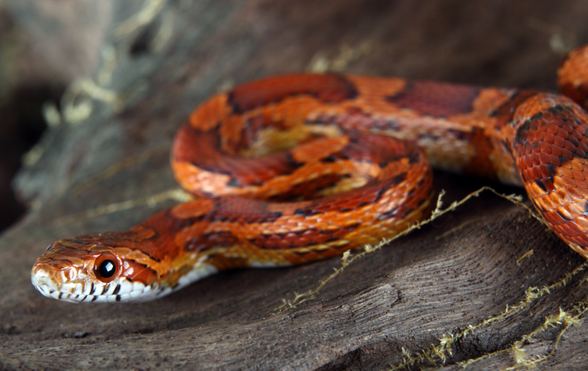The Corn Snake ‘Pantherophis guttatus’ is a colubridea species, native to North America. This species is often the “choice” snake for any new snake keeper due to its placid and docile nature. But for me, regardless of experience, they are a pleasure to keep. And with the average captive age of around 18 years they are certainly a longer term commitment.
Is your Corn Snake insured? Get a quote for £1,000 of vet fees, death and theft cover. Vet fee cover only also available | We’ve been insuring exotic pets since 1996 | Check out our customer reviews on Feefo.
What size vivarium does a Corn Snake need? | Young Corn Snake viv set up | Do you need a heat lamp for a Corn Snake? | Do Corn Snakes need a thermostat? | What’s the best viv temperature for a Corn Snake? | Do Corn Snakes need UVB? | Snake bedding and substrate | Humidity for a Corn Snake | Decor inside your Corn Snakes vivarium | Water and Corn Snakes
ExoticDirect pet insurance strongly believe in responsible pet ownership and work with expert authors to bring you useful pet care information.
Find out more about our Corn Snake insurance.
My experience with Corn Snakes
I keep a Corn Snake still now, having kept and rescued a few before her. I’ve had her from a few weeks old, and she’s now three. So I’ll base all of the below information on the current setup and experience.
What size vivarium does a Corn Snake need?
A baby Corn Snake can be kept in a large Exo – Terra plastic breeder box measuring around 415 mm x 265 mm x 148 mm.
At around six to nine months, you can move your snake to a vivarium measuring around 4 ft x 2 ft x 2 ft.
I’d only do this when I feel the snake is feeding well, and doing as a snake should.
When you consider that your snake will grow between 4ft to 6ft on average in size, the bigger the vivarium better is the only real conclusion.
Many still disagree here with me, and say a young snake will get stressed in such large surroundings. And I agree. But it is also very much dependant of how you setup that enclosure for the benefit of its inhabitant.
Provide hiding areas, substrate, climbing areas, UVB and also importantly for me in a large enclosure, heat from above.
So my Corn has been in her forever home for a few years now. I chose the Vivexotic XL deep. I’m not sure if this exact spec is still available from Vivexotic, but I can guarantee you, they will have similar, or just the same re-branded.
These setups are wooden, with glass sliding front doors. With wood, you’ll have a far more stable environment within, than if you choose glass for example. Glass setups are notoriously hard to keep a good temperature gradient in.
Also written by Pete Hawkins Bearded Dragons and shedding
The vivarium setup for my young Corn Snake
While she was still in her Exo Terra plastic box, as a young Corn Snake, I used the following setup:
- I used a Lucky Reptile mat on the underside of the box for her hot basking area.
- This was controlled via a Microclimate Evo Lite thermostat. But for a heat-mat, any mat-stat will be sufficient. But it is vital (more on this later).
- She had two hides in this setup, one over the basking area, the other over on the opposite side.
- And I also used enough substrate to allow her to bury herself if needed. The substrate choice when this young for me will always be Lignocel.
- I find this light, non-dusty and easy to clean. Yet it allows the snake to have some privacy if needed.
- It is also vital you provide a suitable sized water bowl that allows your snake to sit in if needed.
They generally only do this during the summer months when the room temperature is hot. Thus, the setup will be more arid than normal, so it aids their cooling. They’ll also do it when they are due to shed (more on this later).
As said, at around six to nine months I’d look to put the snake in a large forever home, as long as you feel the snake is doing well.
Also written by Pete Hawkins Bearded Dragons and Brumation
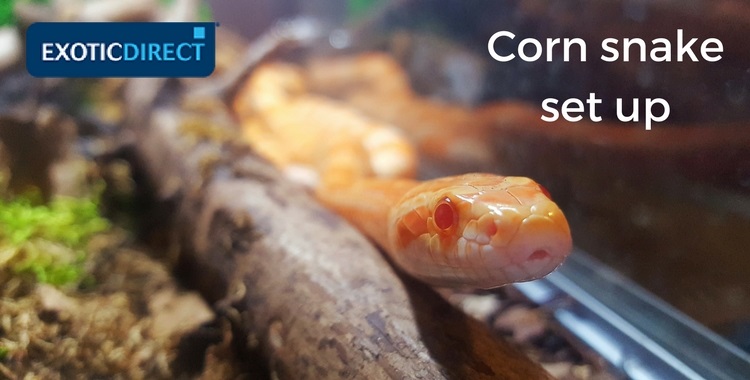 Your Corn Snake’s vivarium should measure around 4ft x 2ft x 2ft
Your Corn Snake’s vivarium should measure around 4ft x 2ft x 2ft
Do you need a heat lamp for a Corn Snake?
Yes you do. Personally, I use the new Arcadia Deep Heat Projector (DHP) for all my snake setups.
With a suitable bulb guard as always, these have now replaced my ‘White Python’ ceramic bulbs I did used to use.
I was lucky enough to aid the testing of this product, and the results were enough for me to warrant the change upon its full retail release.
I found the snakes really did love the intense infrared A and B rays the bulb produces. And as it produces no light, like a ceramic, the change in that respect was no bother to the snake.
You can of course use a ceramic bulb with suitable guard if you choose, and as always, run your chosen heat source through a thermostat. This is a vital piece of safety equipment, it can actually save lives.
Do Corn Snakes need a thermostat?
Yes they do. The thermostat probe ideally wants to be on a wall close to the basking zone. This gives you maximum control of the basking zone, without the snake laying over the probe and messing up and reading.
This could falsely effecting the thermostats output and in turn affect the temperature within the setup.
For any non-light emitting heat-source like the DHP or a ceramic bulb, a pulse or dimming thermostat is best. For me, the ‘Microclimate Evo lite’ is ideal as it has both these functions.
What’s the best vivarium temperature for a Corn Snake?
You want a basking zone temperature to be around 29c-32c. A little under or over is not really an issue if the area is big enough.
Measure using a digital thermometer probe under the basking source for the most accurate reading.
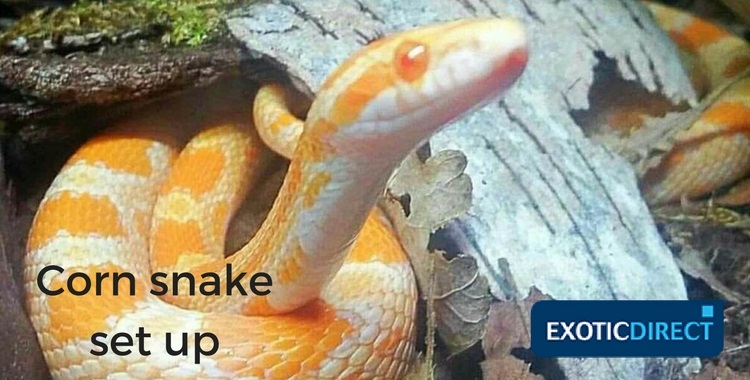 Your corn Snake’s basking temperature should be around 29c – 32c
Your corn Snake’s basking temperature should be around 29c – 32c
Do Corn Snakes need UVB?
Yes, I feel they do and I use UVB with all my snakes. Personally it’s just something I’ve always done. Way back in the day there were no fancy LED’s to illuminate a setup so a UVB tube was the only real option.
Of course, the science and research has progressed within the keeping of such species and although they have survived in captivity without UVB in millions of setups across the world, we absolutely know now that, if it’s provided it will be utilised by the snake.
UV index studies have shown (Ferguson Zones) that in the wild they willingly expose themselves to is around a UVI of 0.6 to 1.4. This is classed as crepuscular or a shade dweller. To which they are the latter. This is easily achieved via the tube and methods mention below.
What I use – my choice of UVB is the Arcadia 6% UVB tube. With a reflector at least half the length of the setup, starting flush in the basking zone. But something similar such as the ZooMed 5.0 would be suitable also.
Use in conjunction with ample shade and hiding places – the snake will get to choose its own exposure to the UVB. This is the most natural way to provide such lighting.
You’ll find someone will always come back with the argument of:
“But these are NOT wild snakes. They are captive bred”. To which I always reply. “Sure they are. But a few decades of captive breeding will NOT undo millions of years of evolution, in which UVB in the wild is accessed and utilised by the snake instinctively”.
The way I see it, would they have access to UVB in wild conditions?. Of course, so we must replicate and emulate wild conditions the best we can.
Is UVB essential for my Corn Snake?
As mentioned in the article, I’m a firm believer in the use of UVB. This will also obviously illuminate the setup, and has benefits to which they have access to in the wild.
But, its also been proven UVB is not needed. This was the case for decades, and still is for many keepers.
So LEDs such as the White Python LED strips, are safe, and usable. In fact I’ve used them myself in the past.
I’d stick to reptile brands as they are tested under the vivaria conditions.
Should I turn off my snake’s heat and UV lamps at night?
I have both heat (CHE) and UVB on a timer (you can do this via the Microclimate Evo) and they operate on a 12 hours on/off cycle.
If you do not have a Microclimate Evo Thermostat to decrease the night temperature a couple of degrees, then the CHE will need to stay on 24/7.
You should turn the UVB off separately after twelve hours, ensuring your Corn Snake is in the dark for a twelve hours. You can plug the UVB into a standard plug timer.
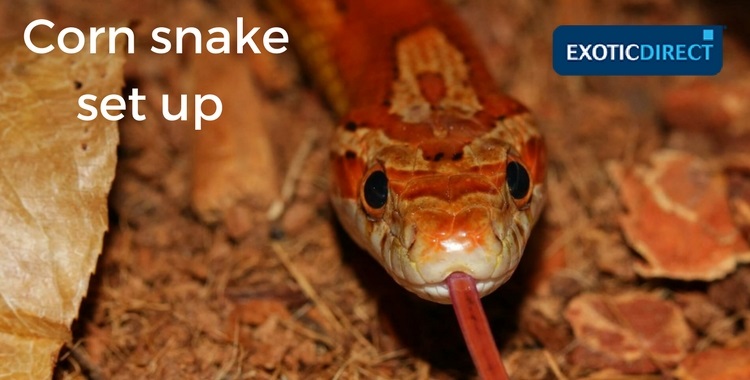 Wood chip is one substrate option for your Corn Snake
Wood chip is one substrate option for your Corn Snake
What is the best thing to use for snake bedding and substrate?
You have a few choices:
- Newspaper
- Aspen
- Lignocel
- Wood Chip
- Sand
- Hemp
- Sand/soil
- Bio-active
- Lino
Substrate is always a subject that will split a crowd. What’s good for one keeper, could be hated by another, hence the pointless back and forth arguments witnessed on social media about such.
Over the past few years, I’ve been very successfully using a bio-active setup for my Corn Snake, as I do with all my snakes.
If you are unfamiliar with this term, it’s basically a fully-fledged eco-system within the enclosure, where the use of a variety of live bugs help maintain the setup by cleaning up waste, etc.
If you’re a reader of Practical Reptile Keeping you may have seen the article I wrote about Royal Python bio enclosures. The setup instructions in this would be the same for a Corn Snake.
If not creating a bio active setup, I recommend using something the snake can utilise, something more natural. Although the likes of lino or aspen are easy to clean, is this the best option for the snake. Or is it best option for the keeper?
I’ll choose and recommend to reflect the snakes needs (or any reptiles). Always.
Even with the best care your Corn Snake could still get ill.
Our Corn Snake insurance can cover your snake for £1,000 of Vet fees. Two more policy options are also available, they include £1,000 of Vet fees, Death and Theft, and Death and Theft only.
Alternatively you can call us on 0345 982 5505
Humidity for a Corn Snake
My Corn Snake’s humidity is around 30-60%, and that’s with a couple of spray downs a week. I have a humidity gauge on my thermometer, but I don’t really do anything else regarding it. I don’t have a humidifier.
Of course my natural setup aids this. If you use something like newspaper you may need to spray much more in order to maintain a decent humidity level.
Also adding mosses in the setup helps maintain a steady humidity level. But with all humidity, a humidity spike is a good thing, this is achieved by spraying and letting the setup completely dry out before spraying again. Extra spraying when they are due to shed will also help this process.
A high humidity level in your snake’s vivarium is only a bad thing if air circulation is bad. Stale air can cause health issues, so if that humidity does not lower naturally, fixing the airflow by adding extra ventilation should remedy the issue.
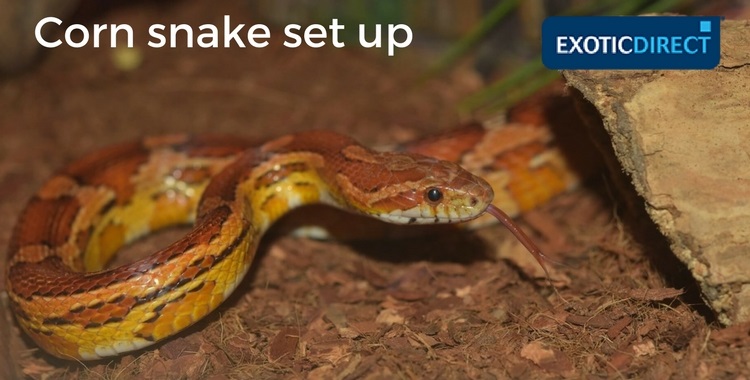 Branches and hides can help provide stimulation for your Corn Snake
Branches and hides can help provide stimulation for your Corn Snake
Décor inside your Corn Snake’s vivarium
Vines, branches and hides are all essential. I use a mixture of items such as branches and wood I collect from outside. Make sure you don’t collect from anywhere near roads though due to carbon pollution, and that you collect from a safe pesticide free area.
Snakes like things to climb, places to hide, mental and physical stimulation. All aid in the health and well being of your snake.
A couple or three large branches stacked on each other will keep the snake busy and active. And the addition of a suitably sized hide in each end of the setup, so the snake has a place to sleep/hide away if needed is also something you must provide.
If you’d prefer not to collect items from outside, then buying from a retailer is just as good, and you won’t need to worry about the presence of any toxins.
Water in my Corn Snakes vivarium
Providing a source of clean water is a must.
Choose something that will not tip over in the setup, but is deep and wide enough to allow your snake to climb in and out as needed.
As already mentioned, snakes do like a good soak on their own terms, usually when too hot, or pre-shed as already touched upon above.
They don’t want, or need baths, so providing a good sturdy bowl is the best option. I opt for a hardy ceramic bowl, dog or cat bowls I think they are.
As the snake gets bigger, the bowl follows suit.
The use of a water conditioner is also something I personally do although many do not bother and have no related issues.
For me, keeping frogs and chameleons where the chlorines in our water can cause harm to their sensitive skin and eyes, a conditioner such as ZooMed ReptiSafe or Exo-Terra Aquitize is something I add a few drops of to each water change.
This removes all the chlorines in the water, and adds vital electrolytes to the water.
Cleaning
As already mentioned within a bio-active setup there is no need to clean it once it’s established.
For any other substrate, be it, aspen, Lignocel, paper, etc spot clean waste as and when it’s noticed. If you’re using paper, just replace it as it’s soiled on.
For anything else, you could clean that area only, and then full clean every couple of weeks.
Shedding in your Corn Snake
Providing your snake is hydrated and has logs, branches, décor etc that enable safe shed removal, all should be perfectly fine.
But occasionally, issues can occur. Reptiles that are poor shedders are often B vitamin deficient, as well as this, the body’s Vitamin E, D3, Calcium, & Magnesium supplies are all essential in aiding the body shed process.
These vital components should be obtained via the rats, chicks, and mice you feed, but for a boost in such essential nutrition it’s worth keeping a pack of Arcadia Shed Support if you had a more patchy shed previously.
This is loaded with a double dose of ‘B’ group vitamins, carotenoids,and bee-pollen. Which has a host of nutrients in itself.
It comes in a capsule form. And can be inserted into the rat or mouse’ mouth.
How long can a snake be out of its vivarium?
Taking your snake out of its vivarium for about thirty minutes weekly I feel is ample, if the setup is up to the standard mentioned in here.
Not only will it give the snake some new sights and smells to engage, but its always a talking point for a keeper.
It’s worth noting, if you are holding the snake, and it starts to get restless, so constantly moving, trying to get up high or down low, it’s usually a sign that the snake is either getting stressed being out or stressed being held. So you should then put back it in the vivarium.
To Conclude:
The above it based on my experiences, but it’s also what I recommend within my Snake group on Facebook (Snake Network) and any reptile related meet or discussion I attend.Of course, there are many reptile related brands that do the same job as to the number of brands I have mentioned above. So here, the choice is yours.
I know what I do works. I have a vet check every six months as well as yearly faecal tests which I advise for all reptiles kept.
And the fact I’ve had a clear bill of health, and clear faecals for the past five years for all my snakes shows what I’m doing is working.
Pete Hawkins is an administrator on a number of Facebook reptile groups such as the Snake Network and the Bearded Dragon Network
Pete also writes for The Reptile Apartment and Practical Reptile Keeping.

